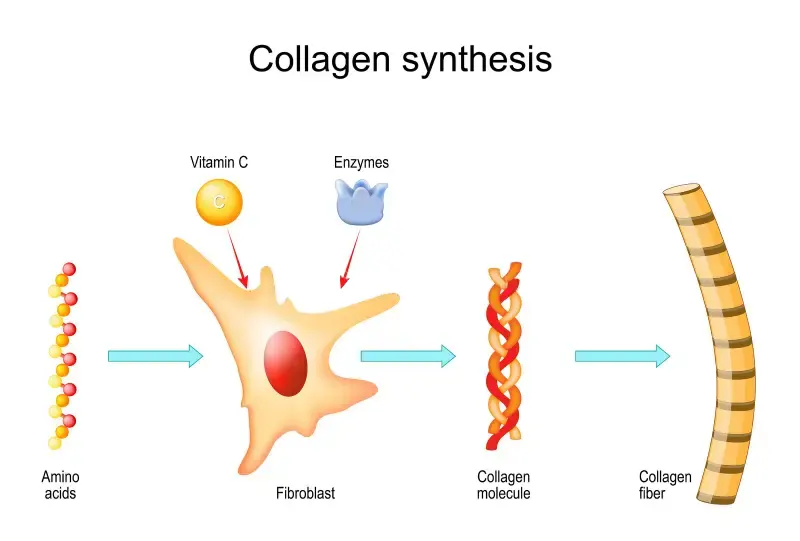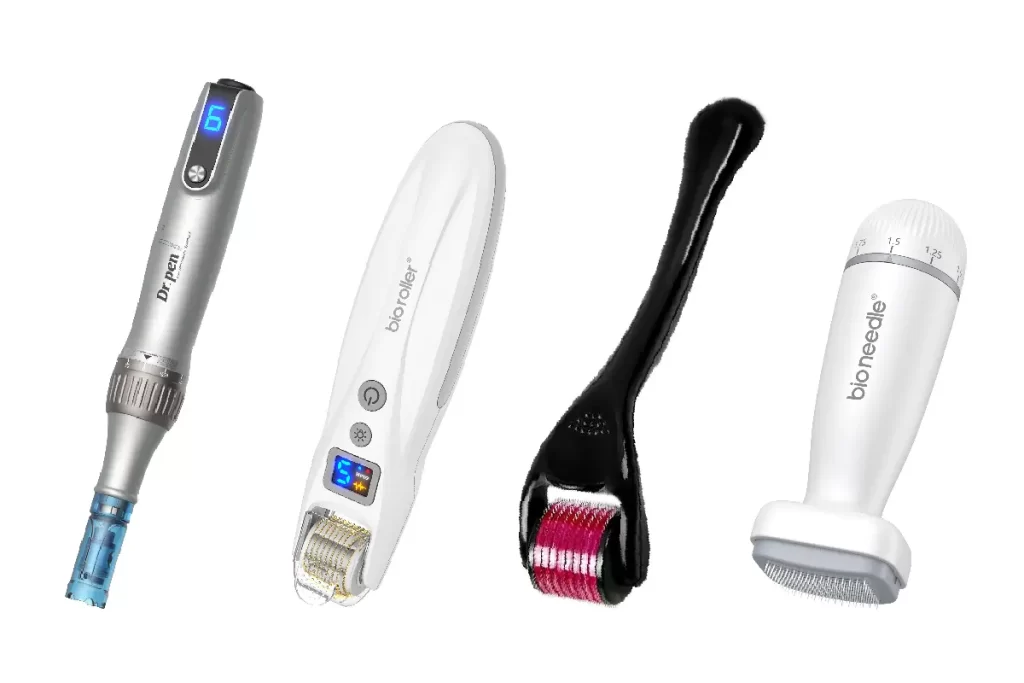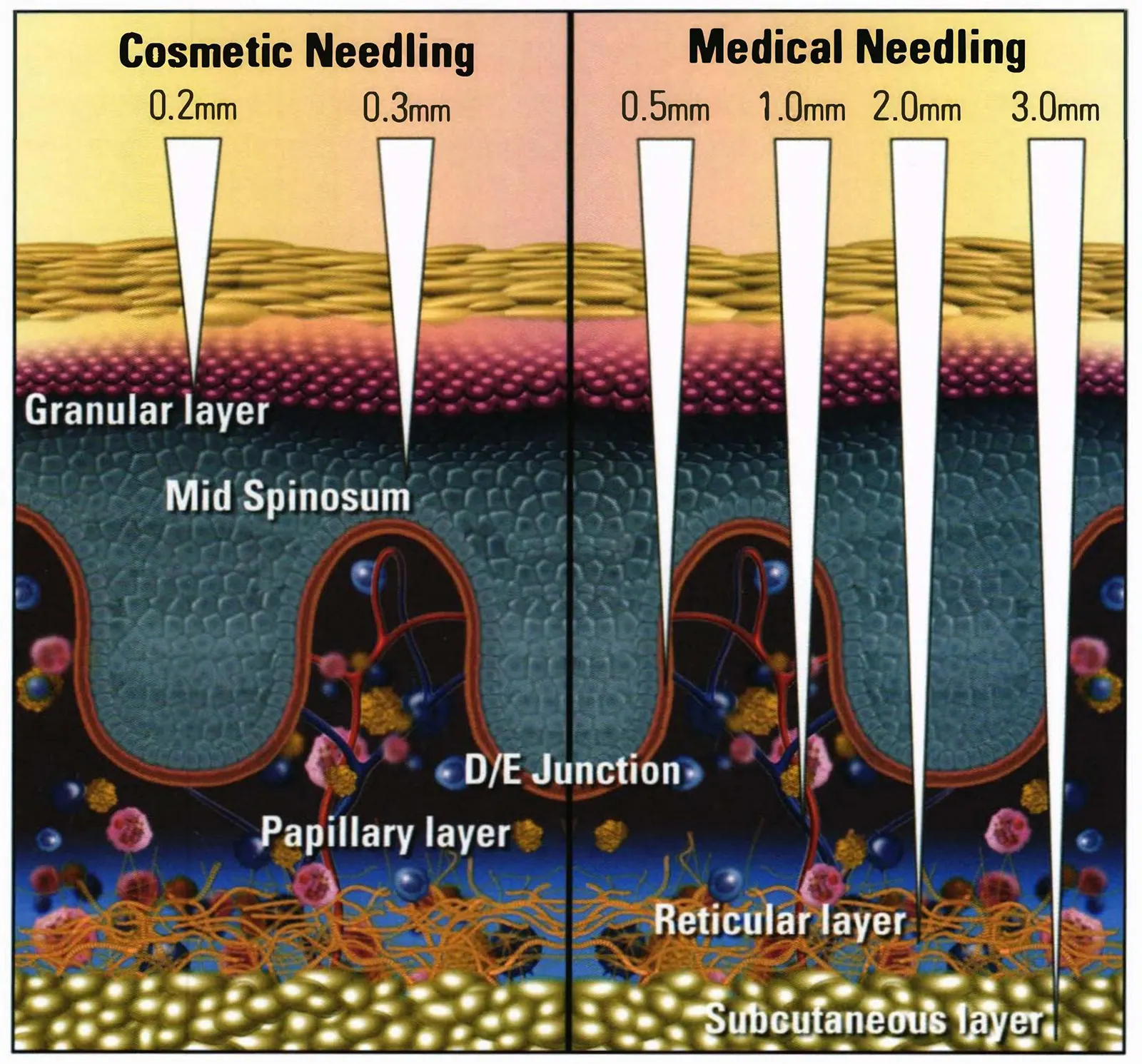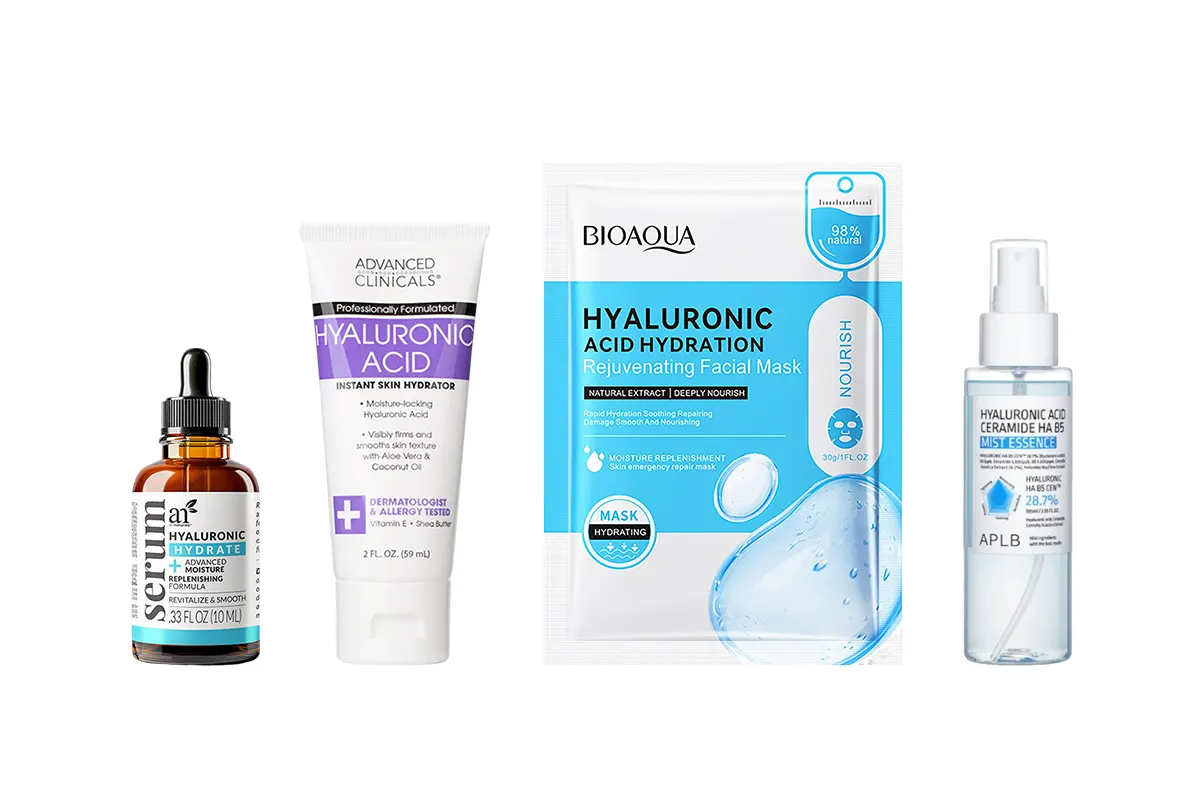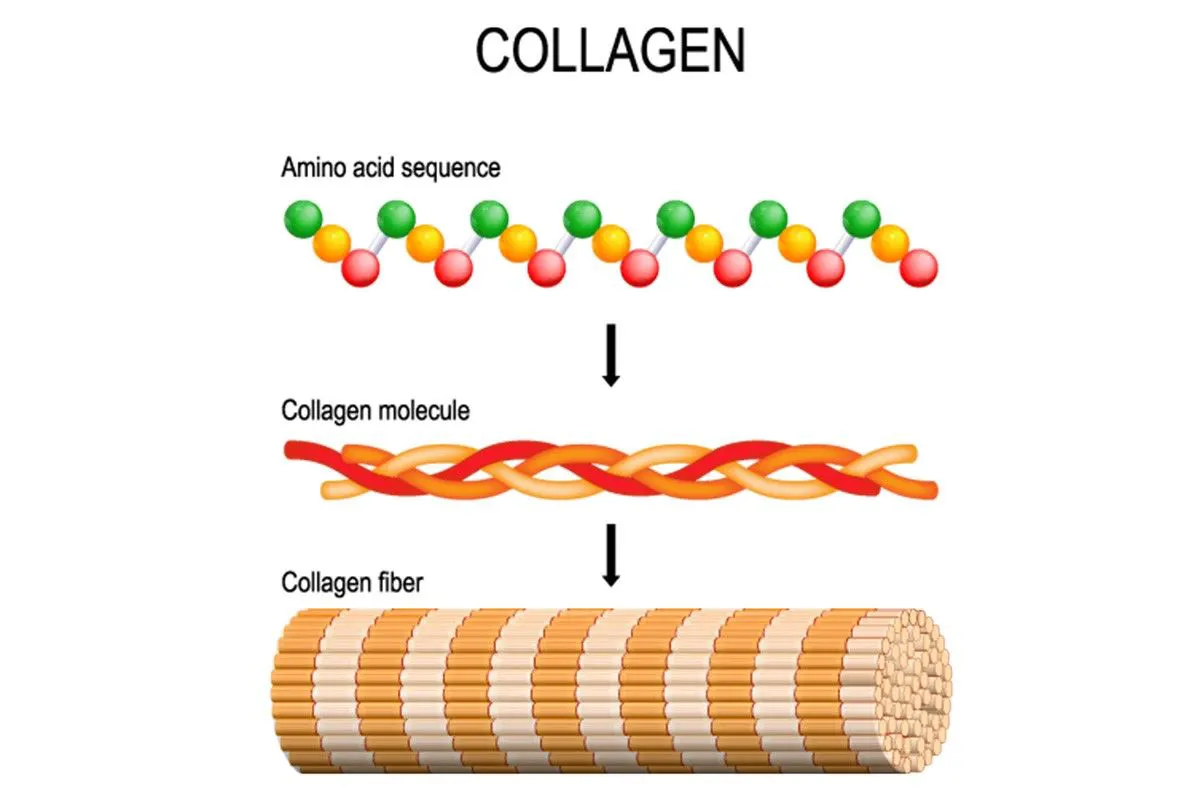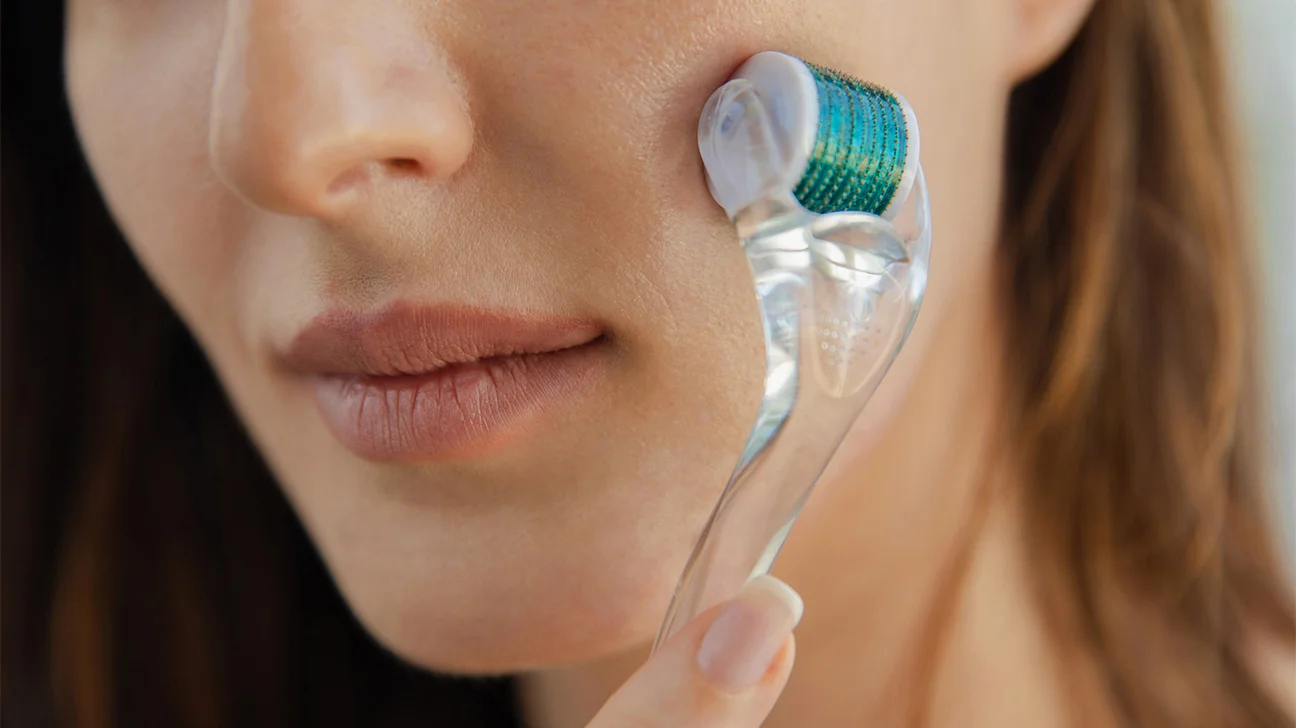Collagen is the main protein component of fibrous connective tissue, which is part of the skin tissue. The main function of collagen is to help maintain the support and structural integrity of the skin tissue, and it is a key factor in determining the plumpness and elasticity of the skin. Therefore, stimulating the production of collagen has become the main goal of most skin regeneration treatments.
Collagen is produced by fibroblasts. Whether it is fibroblast proliferation or collagen synthesis and strengthening, sufficient nutrients are required.
The following nutrients are necessary:
Vitamin C
Vitamin C specifically increases levels of type 1 and type 3 procollagen messenger RNA in human fibroblasts.
Collagen requires vitamin C and iron for “hydroxylation”—adding OH groups—or converting the amino acids proline and lysine into hydroxyproline and hydroxylysine. These substances help bind collagen fibers together into a strong, “rope-like” triple helix. Without vitamin C and iron, hydroxylation does not occur and collagen cannot form a triple helix, resulting in weaker connective tissue. This may interfere with wound healing and accelerate the aging process.
Vitamin A
Retinol, a derivative of vitamin A, can help maintain skin structure by inhibiting the expression of MMPs and reducing collagen degradation. (Matrix metalloproteinases (MMPs) are a group of zinc-dependent proteases responsible for breaking down structural proteins in the extracellular matrix (ECM), such as collagen, elastin, and fibronectin. As we age, the expression level of matrix metalloproteinases (MMPs) in cells increases, which accelerates the breakdown of collagen and elastin. The reduction of collagen and elastin can cause the skin to lose elasticity and firmness, leading to wrinkles and sagging. This is one of the main causes of skin aging.)
In addition, retinol can also regulate cell proliferation and differentiation and increase the number of fibroblasts through gene transcription. Fibroblasts produce more collagen.
Hyaluronic Acid (HA)
Hyaluronic acid (HA) is an important component of the skin matrix, especially in the dermis of the skin. It plays an important role in skin wound healing and collagen production.
Effect on wound healing:
In the early stage of wound healing, HA provides a good environment by enhancing intercellular adhesion and supporting the matrix, promoting the migration and proliferation of fibroblasts, keratinocytes and endothelial cells.
In the later stage of wound healing, HA helps tissue matrix remodeling, supports the formation of new blood vessels, and provides structural support to enhance the overall repair quality of the skin.
Effect on collagen synthesis:
Hyaluronic acid activates the intracellular signal transduction pathway by binding to receptors on the surface of fibroblasts, thereby promoting collagen synthesis. It helps regulate the expression of growth factors such as TGF-β, which can stimulate fibroblasts to produce more collagen.
Hyaluronic acid also has an indirect effect on the cross-linking process of collagen, enhancing the stability and antioxidant capacity of collagen. Cross-linked collagen forms a stronger network in the skin, which increases its strength and elasticity.
Amino Acids
In the synthesis of collagen, proline, lysine and glycine are key amino acids, which play different roles in forming the triple helix structure and function of collagen.
Proline:
Proline accounts for a high proportion in collagen and is an important component of the triple helix structure. Its ring structure makes it more rigid and is essential for the construction and maintenance of the triple helix. Proline gives collagen fibers a certain rigidity, making them more resistant to stretching under stress.
Lysine:
Lysine plays a key role in the cross-linking formation of collagen fibers. Lysine can enhance the strength and elasticity of collagen fibers. Lysine and hydroxylysine make collagen fibers stronger and more stable by forming covalent cross-links (catalyzed by lysyl oxidase).
Glycine:
Glycine is the most abundant amino acid in collagen, accounting for one-third of all amino acids. Its small molecular structure makes it very flexible and fits into the small space of the collagen triple helix, providing structural tightness to the triple helix and ensuring that it can form stably and compactly. Glycine is an important contributor to the stability of collagen, giving it high mechanical strength.
Copper Peptides
Copper is one of the elements that fibroblasts need to synthesize collagen. Certain types of peptides have a strong affinity for copper, and they bind tightly to copper. The resulting compound consisting of peptides and copper atoms is called a copper peptide.
GHK-Cu:
GHK-Cu (Glycyl-L-Histidyl-L-Lysine-Copper Complex, full name: Glycyl-L-Histidyl-L-Lysine-Copper) is a copper peptide that accelerates wound healing by regulating metalloproteinases (MMPs) in the skin and balancing the decomposition and production of collagen. It can stimulate the activity of fibroblasts, promote the synthesis of elastin, proteoglycans, glycosaminoglycans and other components of the dermis, improve skin firmness and elasticity, and slow down the formation of wrinkles.
GHK-Cu is particularly important in the early stages of wound healing because it promotes the gradual repair of wounds from deep to surface layers by stimulating the production of type I and type III collagen, forming functional connective tissue rather than disordered scar tissue. In addition, it improves wound healing quality, enhances wound remodeling, reduces the likelihood of scarring, and even improves the aged connective tissue found in scars by regulating the activity of fibroblasts and metalloproteinases (MMPs).
AHK-Cu:
AHK-Cu (L-AHK-Cu(alanyl-L-histidyl-L-lysine-Cu2+) promotes the growth of human hair follicles. This stimulation can promote the proliferation and prevent apoptosis of dermal papilla cells (DPCs). Dermal papilla cells (DPCs) are a special type of fibroblast that is essential for the morphogenesis and growth of hair follicles.
Zinc Fingers
Zinc fingers are the most common transcription factors in living organisms and consist of amino acids linked together by zinc. By fusing selected zinc finger peptides to an inhibitory or activating domain, genes can be selectively turned on or off by targeting the peptide to the desired gene target. In theory, zinc fingers allow us to repair DNA, increase the positive effects of cellular function (collagen, elastin, GAGs, etc.), and reduce aging.
Bioflavonoids
Bioflavonoids are plant-derived antioxidants that have been shown in numerous studies to play a unique role in protecting vitamin C from oxidation in the body, allowing the body to reap even more benefits from vitamin C. Bioflavonoids are thought to benefit connective tissue by binding to elastin, preventing it from being degraded by elastase, which is released in response to inflammation. In addition to this apparent enzyme inhibition, bioflavonoids also exhibit enzyme activation, promoting the activation of proline hydroxylase, an enzyme necessary for collagen cross-linking.
Both of the bioflavonoids listed below have additional effects on the circulatory system, making them “active” additions to any anti-aging product formulation.
Grape Seed Extract (Vitis Vinefera):
In addition to its circulatory benefits, protective antioxidant effects, and anti-inflammatory properties, this extract contains proanthocyanidins (polyphenol antioxidants) that are very effective in helping to reduce the damaging effects of the sun, which inevitably lead to oxidative stress and subsequent lipid peroxidation.
Green Tea Extract ( Camellia Sinensis ):
An important feature of green tea is its ability to inhibit MMP enzymes (collagenase). This is, of course, crucial when treating aging skin or skin that is frequently exposed to the sun. The methylxanthine content in green tea also acts on the small capillaries of the microcirculation to reduce angiogenesis and erythema. Some studies have shown that green tea has sun protection (SPF) properties and is currently being formulated into sunscreen products.
Iron
Iron is essential for the activity of proline hydroxylase, as it is an essential cofactor for this enzyme. Proline hydroxylase helps convert proline into hydroxyproline. Hydroxyproline is one of the key amino acids of collagen and an important component of the triple helix structure of collagen.
Calcium, Silicon, Selenium, Magnesium
Calcium acts as a regulator of keratinocyte proliferation and differentiation. In wound repair, calcium is primarily involved in the hemostatic phase as factor IV, but calcium is also required for epidermal cell migration and regeneration patterns in the later stages of healing.
Silicon is an important micronutrient required for connective tissue formation.
Magnesium and selenium play a crucial role in endogenous antioxidant defense mechanisms and immunity.
Glucosamine
Oral administration of adequate amounts of glucosamine within the first few days of skin microinjury enhances hyaluronan production in wounds, promoting faster healing and reducing scar-related complications.
Rapid hyaluronan production by fibroblasts in the early stages of wound healing may be critical because hyaluronan stimulates migration and mitosis of mesenchymal and epithelial cells.
Alpha-linolenic and Linoleic Acid
Essential fatty acids are essential for maintaining the vitality of keratinocyte membrane phospholipids. The main sources of omega 3 used by the cosmetic industry are hemp seed oil, flax seed oil, kiwi seed oil and soybean oil.
Fish oil is widely used as a supplement, and some fish roe and algae are used as sources of omega 3, such as spirulina, which is also a source of natural proline.
Stem Cell Products
Stem cells are able to self-renew through mitosis and differentiate into a variety of specialized cell types. During this process of stem cell division and proliferation, a large number of growth factors and cytokines are produced.
The actual stem cells are not contained in skin care products. Instead, the growth factors and cytokines they secrete when cultured in a nutrient solution are isolated and put into the products. These bioactive signaling molecules enhance intercellular communication and stimulate existing cells to function at a higher level to promote skin regeneration.

